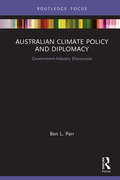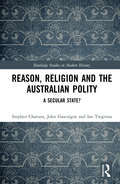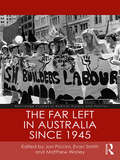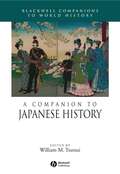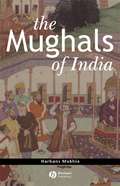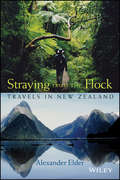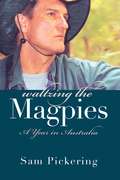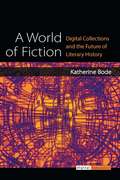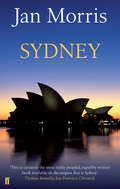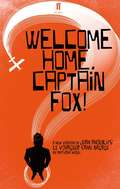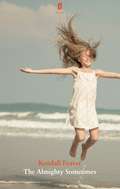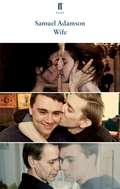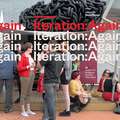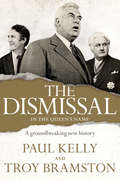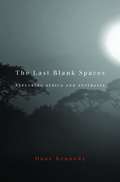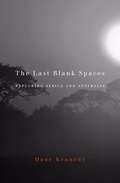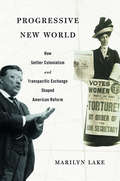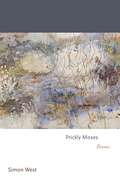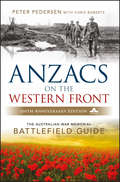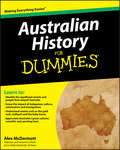- Table View
- List View
Australian Climate Policy and Diplomacy: Government-Industry Discourses (Routledge Focus on Environment and Sustainability)
by Ben L. ParrAustralian Climate Policy and Diplomacy provides a well overdue critique of existing, and high-profile, publications that convey the ‘greenhouse mafia’ hypothesis, which posits that Australia’s weak policy response to climate change is the result of a menacing domestic fossil fuel lobby. Ben L. Parr argues that the shared government–industry discourse about protecting Australia’s industrial competitiveness has had a more decisive influence in shaping and legitimising Australian climate policy than the direct lobbying tactics of the fossil fuel industry. Parr also reveals how the divergent foreign policy discourses and traditions of Australia’s two major political parties – as internationalist versus alliance-focused – have enabled and constrained their climate diplomacy and domestic policies over time. To demonstrate his argument, he presents a discourse analysis woven into a chronological policy narrative, comprising more than 1000 primary texts (media releases, interviews, and speeches) generated by prime ministers and key fossil fuel lobbyists. Overall, this volume illustrates how domestic forces have and are influencing Australia’s climate policy. In doing so, it also provides a framework that can be adapted to examine climate mitigation policies in other countries, notably Canada and the US. This book will be of interest to students and scholars of climate change, environmental policy and governance, and Australian climate change policy and politics more specifically, as well as policymakers and practitioners working in these fields.
Reason, Religion and the Australian Polity: A Secular State? (Routledge Studies in Modern History)
by Stephen A. Chavura John Gascoigne Ian TregenzaHow did the concept of the secular state emerge and evolve in Australia and how has it impacted on its institutions? This is the most comprehensive study to date on the relationship between religion and the state in Australian history, focusing on the meaning of political secularity in a society that was from the beginning marked by a high degree of religious plurality. This book tracks the rise and fall of the established Church of England, the transition to plural establishments, the struggle for a public Christian-secular education system, and the eventual separation of church and state throughout the colonies. The study is unique in that it does not restrict its concern with religion to the churches but also examines how religious concepts and ideals infused apparently secular political and social thought and movements making the case that much Australian thought and institution building has had a sacral-secular quality. Social welfare reform, nationalism, and emerging conceptions of citizenship and civilization were heavily influenced by religious ideals, rendering problematic traditional linear narratives of secularisation as the decline of religion. Finally the book considers present day pluralist Australia and new understandings of state secularity in light of massive social changes over recent generations.
Reason, Religion and the Australian Polity: A Secular State? (Routledge Studies in Modern History)
by Stephen A. Chavura John Gascoigne Ian TregenzaHow did the concept of the secular state emerge and evolve in Australia and how has it impacted on its institutions? This is the most comprehensive study to date on the relationship between religion and the state in Australian history, focusing on the meaning of political secularity in a society that was from the beginning marked by a high degree of religious plurality. This book tracks the rise and fall of the established Church of England, the transition to plural establishments, the struggle for a public Christian-secular education system, and the eventual separation of church and state throughout the colonies. The study is unique in that it does not restrict its concern with religion to the churches but also examines how religious concepts and ideals infused apparently secular political and social thought and movements making the case that much Australian thought and institution building has had a sacral-secular quality. Social welfare reform, nationalism, and emerging conceptions of citizenship and civilization were heavily influenced by religious ideals, rendering problematic traditional linear narratives of secularisation as the decline of religion. Finally the book considers present day pluralist Australia and new understandings of state secularity in light of massive social changes over recent generations.
The Far Left in Australia since 1945 (Routledge Studies in Radical History and Politics)
by Jon Piccini Evan Smith Matthew WorleyThe far left in Australia had significant effects on post-war politics, culture and society. The Communist Party of Australia (CPA) ended World War II with some 20,000 members, and despite the harsh and vitriolic Cold War climate of the 1950s, seeded or provided impetus for the re-emergence of other movements. Radicals subscribing to ideologies beyond the Soviet orbit – Maoists, Trotskyists, anarchists and others – also created parties and organisations and led movements. All of these different far left parties and movements changed and shifted during time, responding to one political crisis or another, but they remained steadfastly devoted to a better world. This collection, bringing together 14 chapters from leading and emerging figures in the Australian and international historical profession, for the first time charts some of these significant moments and interventions, revealing the Australian far left’s often forgotten contribution to the nation’s history.
The Far Left in Australia since 1945 (Routledge Studies in Radical History and Politics)
by Jon Piccini Evan Smith Matthew WorleyThe far left in Australia had significant effects on post-war politics, culture and society. The Communist Party of Australia (CPA) ended World War II with some 20,000 members, and despite the harsh and vitriolic Cold War climate of the 1950s, seeded or provided impetus for the re-emergence of other movements. Radicals subscribing to ideologies beyond the Soviet orbit – Maoists, Trotskyists, anarchists and others – also created parties and organisations and led movements. All of these different far left parties and movements changed and shifted during time, responding to one political crisis or another, but they remained steadfastly devoted to a better world. This collection, bringing together 14 chapters from leading and emerging figures in the Australian and international historical profession, for the first time charts some of these significant moments and interventions, revealing the Australian far left’s often forgotten contribution to the nation’s history.
A Companion to Japanese History (Wiley Blackwell Companions to World History #9)
by William M. TsutsuiA Companion to Japanese History provides an authoritative overview of current debates and approaches within the study of Japan’s history. Composed of 30 chapters written by an international group of scholars Combines traditional perspectives with the most recent scholarly concerns Supplements a chronological survey with targeted thematic analyses Presents stimulating interventions into individual controversies
The Mughals of India (Peoples of Asia #5)
by Harbans MukhiaThis innovative book explores of the grandest and longest lasting empire in Indian history. Examines the history of the Mughal presence in India from 1526 to the mid-eighteenth century Creates a new framework for understanding the Mughal empire by addressing themes that have not been explored before. Subtly traces the legacy of the Mughals’ world in today’s India.
Straying from the Flock: Travels in New Zealand
by Alexander ElderAn illuminating road trip through the history, life, and attractions of one of the most beautiful countries in the southern hemisphere The beauty and grandeur of New Zealand has captured the imagination of movie-goers over the past couple of years, and the country is a dream destination for many around the world. Straying from the Flock is an intimate and personal account of one passionate traveler's visit to this incredible country, its mountains and beaches, fjords, rainforests, vineyards, and hidden eateries. Each of the fifty chapters describes one day in his travels-fishing, flying, cattle herding, befriending locals at every turn. Filled with colorful stories and memorable personalities, the book not only describes the trip of a lifetime, but captures a life-altering experience for its writer. From mountains and rainforests to cities and beaches, Straying from the Flock is both a moving memoir and personal travel guide to this amazing country.
Waltzing the Magpies: A Year in Australia
by Sam PickeringPraise for Sam Pickering: "The art of the essay as delivered by Mr. Pickering is the art of the front porch ramble." ---The New York Times Book Review "Reading Pickering . . . is like taking a walk with your oldest, wittiest friend." ---Smithsonian "What a joy it is to 'mess around' with Professor Sam Pickering!" ---The Chattanooga Times "Pickering is a barefoot observer of the quotidian who revels in the spectacle and its gift for surprise, prefers the rumpled to the starched, has raised puttering and messing about to an art form, and wrings from it more than a pennyworth of happiness and a life well lived." ---Kirkus Reviews The movie Dead Poets Society is where most Americans first met Sam Pickering, the University of Connecticut English professor. Robin Williams plays the lead character (loosely based on Pickering), an idiosyncratic instructor who employs some over-the-top teaching methods to keep his subjects fresh and his students learning. Fewer know that Pickering is the author of more than 16 books and nearly 200 articles, or that he's inspired thousands of university students to think in new ways. And, while Williams may have captured Pickering's madcap classroom antics, he didn't uncover the other side of the author-Sam Pickering as one of our great American men of letters. Like the music of Mozart, the painting of Picasso, or the poetry of Emily Dickinson, you can spot Pickering's writing a mile away; there's no mistaking the Pickering pen. As an ample demonstration of the author's literary gifts, Waltzing the Magpies is his unabashedly lush and Technicolor travelogue from Down Under. On the face of it, Waltzing is the chronicle of a sabbatical year spent with family in Australia. Yet beneath the surface Pickering's big themes-family, nature, seizing the moment-move in a powerful current that frequently bursts out in moments of ecstatic revelation and intense sensual flourish. Through it all Pickering weaves stories from his fictional Southern town of Carthage, Tennessee, especially when the goings of the outside world get rough. Waltzing the Magpies is classic Pickering at the height of his literary powers, and places him in the company of such great American essayists as E. B. White and James Thurber, but with an irony and observational prowess that is pure Pickering.
A World of Fiction: Digital Collections and the Future of Literary History (Digital Humanities)
by Katherine BodeDuring the 19th century, throughout the Anglophone world, most fiction was first published in periodicals. In Australia, newspapers were not only the main source of periodical fiction, but the main source of fiction in general. Because of their importance as fiction publishers, and because they provided Australian readers with access to stories from around the world—from Britain, America and Australia, as well as Austria, Canada, France, Germany, New Zealand, Russia, South Africa, and beyond—Australian newspapers represent an important record of the transnational circulation and reception of fiction in this period. Investigating almost 10,000 works of fiction in the world’s largest collection of mass-digitized historical newspapers (the National Library of Australia’s Trove database), A World of Fiction reconceptualizes how fiction traveled globally, and was received and understood locally, in the 19th century. Katherine Bode’s innovative approach to the new digital collections that are transforming research in the humanities are a model of how digital tools can transform how we understand digital collections and interpret literatures in the past.
Sydney
by Jan MorrisRenowned and much-loved travel writer Jan Morris turns her eye to Sydney: 'not the best of the cities the British Empire created ... but the most hyperbolic, the youngest at heart, the shiniest.' Sydney takes us on the city's journey from penal colony to world-class metropolis, as lively and charming as the city it describes. With characteristic exuberance and sparkling prose, Jan Morris guides us through the history, people and geography of a fascinating and colourful city. Jan Morris's collection of travel writing and reportage spans over five decades and includes such titles as Venice, Hong Kong, Spain, Manhattan '45, A Writer's World and the Pax Britannica Trilogy. Hav, her novel, was shortlisted for the Booker Prize and the Arthur C. Clarke Award. 'Sydney should be flattered. A great portrait painter has chosen it for her recent subject . . . Few writers - a handful of novelists apart - have got so far under the city's skin as Morris . . . Few Sydneysiders could match her knowledge of their city's history and its anecdotes' The Times 'The writing is, at times, like surfing: sentences rise like vast waves above which she rides, never overbalancing into gush . . . Jan Morris convincingly explains modern Sydney through its history' Observer
Welcome Home, Captain Fox! (Faber Drama Ser.)
by Anthony WeighIt's the legendary hot summer of 1959 and while the Cold War rages and America tunes into I Love Lucy, Captain Jack Fox - believed missing in action in the fields of France fifteen years before - is about to be reunited with his family in the Hamptons.But is this really Jack Fox? And if it isn't, who is this man? And why are there twenty-two other families so intent on claiming him as their own?A sparkling comedy of identity, lost and found, based on Jean Anouilh's hit 1937 play, Le Voyageur sans bagage, Anthony Weigh's Welcome Home, Captain Fox! premiered at the Donmar Warehouse, London, in February 2016.
The Almighty Sometimes
by Kendall FeaverI'm older now. I'm stronger. How do you know I haven't sorted out some natural equilibrium all on my own? Maybe we should try it, just for a bit.Diagnosed with a severe mental illness as a child, Anna was prescribed a cocktail of pills. Now a young adult, she's wondering how life might feel without them. But as she tries to move beyond the labels that have defined her, her mother feels compelled to intervene - threatening the fragile balance they have both fought so hard to maintain.Winner of a Judges Award at the 2015 Bruntwood Prize for Playwriting, Kendall Feaver's The Almighty Sometimespremiered at the Royal Exchange, Manchester, in February 2018.
Wife
by Samuel Adamson- And your husband forgave you. But what did you do? Decided that forgiveness was offensive and walked out on your marriage. With nothing. Into nothing.- Into everything, I think.It's 1959. Robert leaves Ibsen's A Doll's House outraged by its attack on the sanctity of marriage; his wife Daisy dashes round to the stage door, in love with both Nora and the actress who plays her, thrilled by their promise of escape.Daisy is at the crossroads. Her moral compass tells her to go one way, society the other. What she chooses to do next will have consequences not just for her and Robert, but for four couples who come after them over ninety years.The truth is we have to give up parts of ourselves if we want to be with someone. And what if, before you know this, you run away from the wrong person?Samuel Adamson's Wife premiered at the Kiln Theatre, London, in May 2019.
Iteration: 13 Public Art Projects Across Tasmania:again
by David CrossIteration:Again documents and reflects upon a series of thirteen temporary public art commissions by twenty-one Australian and international artists that took place across Tasmania from September 18 to October 15, 2011. Produced by Contemporary Art Spaces Tasmania and David Cross, in conjunction with seven partner curators, Iteration:Again presents a compelling array of temporary artworks in largely unexpected places throughout Tasmania. Working to transform our experience of place for a moment in time, each commission seeks to address how temporary interventions or responses by artists to public sites, environments and buildings can serve to open up new ways of understanding Tasmania as a place with very complex cultural, social and spatial resonances. How it might be possible to introduce transformative elements that challenge the notion of a fixed or definitive artwork grounded in one location? By asking the artists to make four different chapters or ‘iterations’ over the course of a four-week period, David Cross challenged each practitioner to think through how change or processes of transition may function to make the art experience an unstable and contingent one. This idea of incorporating change into the work highlights a growing interest by artists in emphasizing art as a potentially theatrical or even fictive medium with the audience experiencing different moments or stages of encounter over a number of weeks. The idea provided for the possibility of narrative sequences, formal investigations, or temporal shifts that saw key additions or subtractions over time. Each commission sought to recast our understanding of public artwork from a discrete event or viewing experience, to a suite of experiences.
The Dismissal: In the Queen's Name (PDF)
by Troy Bramston Paul KellyThere is no more dramatic event in our political history than the dismissal. This book is the definitive story, filled with fresh documents, revelations and new interviews that change our understanding of this event. It is also a brilliant forensic analysis of the ruthless, proud and stubborn main players - Malcolm Fraser, Gough Whitlam and Sir John Kerr. As keys to our understanding, Kelly and Bramston examine four central aspects of the dismissal- the real attitude of Buckingham Palace towards Kerr; whether Kerr tipped Fraser off about his plan; Kerr's deception of Whitlam; and Kerr's dealings with former High Court judges Sir Garfield Barwick and Sir Anthony Mason. In the gripping story that follows, the ambitions and flaws of Whitlam, Fraser and Kerr are laid bare as never before. Drawing on a range of new sources, some of which have never before been made public - including hundreds of pages from Kerr's archives - this remarkable account is dispassionate in its analysis, vivid in its narrative and brutal in its conclusions. It exposes the true motivations, the extent of the deceit and the scale of the collusion.
The Dismissal: In the Queen's Name
by Troy Bramston Paul KellyThere is no more dramatic event in our political history than the dismissal. This book is the definitive story, filled with fresh documents, revelations and new interviews that change our understanding of this event. It is also a brilliant forensic analysis of the ruthless, proud and stubborn main players - Malcolm Fraser, Gough Whitlam and Sir John Kerr. As keys to our understanding, Kelly and Bramston examine four central aspects of the dismissal- the real attitude of Buckingham Palace towards Kerr; whether Kerr tipped Fraser off about his plan; Kerr's deception of Whitlam; and Kerr's dealings with former High Court judges Sir Garfield Barwick and Sir Anthony Mason. In the gripping story that follows, the ambitions and flaws of Whitlam, Fraser and Kerr are laid bare as never before. Drawing on a range of new sources, some of which have never before been made public - including hundreds of pages from Kerr's archives - this remarkable account is dispassionate in its analysis, vivid in its narrative and brutal in its conclusions. It exposes the true motivations, the extent of the deceit and the scale of the collusion.
The Last Blank Spaces: Exploring Africa And Australia
by Dane KennedyThe challenge of opening Africa and Australia to British imperial influence fell to a coterie of proto-professional explorers who sought knowledge, adventure, and fame but often experienced confusion, fear, and failure. The Last Blank Spaces follows the arc of these explorations, from idea to practice, intention to outcome, myth to reality.
The Last Blank Spaces: Exploring Africa And Australia
by Dane KennedyThe challenge of opening Africa and Australia to British imperial influence fell to a coterie of proto-professional explorers who sought knowledge, adventure, and fame but often experienced confusion, fear, and failure. The Last Blank Spaces follows the arc of these explorations, from idea to practice, intention to outcome, myth to reality.
Progressive New World: How Settler Colonialism and Transpacific Exchange Shaped American Reform
by Marilyn LakeIn a bold argument, Marilyn Lake shows that race and reform were mutually supportive as Progressivism became the political logic of settler colonialism at the turn of the 20th century. She points to exchanges between American and Australasian reformers who shared racial sensibilities, along with a commitment to forging an ideal social order.
Progressive New World: How Settler Colonialism and Transpacific Exchange Shaped American Reform
by Marilyn LakeIn a bold argument, Marilyn Lake shows that race and reform were mutually supportive as Progressivism became the political logic of settler colonialism at the turn of the 20th century. She points to exchanges between American and Australasian reformers who shared racial sensibilities, along with a commitment to forging an ideal social order.
Prickly Moses: Poems
by Simon WestCompelling poems that celebrate language as it encounters the nameless variety of the natural world, from Australia to ItalyAn uncanny blend of the external and the intimate has been a hallmark of Simon West’s poetry for nearly twenty years. In this new collection, the Australian poet and Italianist delights in the transforming and endlessly varied powers of naming and speaking. West’s intensely regional focus stands in dialogue with Europe and antiquity. Landscapes reveal the tangle of their historical dimensions, as the rivers of both the Goulburn Valley in southeastern Australia and the Po Valley in northern Italy merge and flow into the wider currents of the Southern Ocean. Again and again, language and the senses throw themselves into the nameless riot of the world, from eucalypts and clouds to a medieval bell tower and the sounds a pencil makes as it crosses a page.
ANZACS on the Western Front: The Australian War Memorial Battlefield Guide
by Peter PedersenA newly updated, lavishly illustrated account of the ANZACs involvement in the Western Front—complete with walking and driving tours of 28 battlefields. With rare photographs and documents from the Australian War Memorial archive and extensive travel information, this is the most comprehensive guide to the battlefields of the Western Front on the market. Every chapter covers not just the battles, but the often larger-than-life personalities who took part in them. Following a chronological order from 1916 through 1918, the book leads readers through every major engagement the Australian and New Zealanders fought in and includes tactical considerations and extracts from the personal diaries of soldiers. Anzacs On The Western Front: The Australian War Memorial Battlefield Guide is the perfect book for anyone who wants to explore the battlefields of the Western Front, either in-person or from the comfort of home. It does far more than show where the lines that generals drew on their maps actually ran on the ground and retrace the footsteps of the men advancing towards them. It is a graphic and wide-ranging record of the Australian and New Zealand achievements, and of the huge sacrifices both nations made, in what is still arguably the most grueling episode in their history. A complete guide to the ANZAC battlefields on the Western Front—featuring short essays on important personalities and events, details on relevant cemeteries, museums, memorials and nearby places of interest, and general travel information. Carefully researched and illustrated with colorful maps and both modern and period photographs. Includes information about the Sir John Monash Centre near Villers-Bretonneux in France—a new interpretative museum set to open on Anzac Day 2018, coinciding with the centenary of the Year of Victory 1918. Anzacs On The Western Front: The Australian War Memorial Battlefield Guide is the perfect book for historians, history buffs, military enthusiasts, and Australians and New Zealanders who want to explore the military history and battlefields of their heritage.
ANZACS on the Western Front: The Australian War Memorial Battlefield Guide
by Peter PedersenA newly updated, lavishly illustrated account of the ANZACs involvement in the Western Front—complete with walking and driving tours of 28 battlefields. With rare photographs and documents from the Australian War Memorial archive and extensive travel information, this is the most comprehensive guide to the battlefields of the Western Front on the market. Every chapter covers not just the battles, but the often larger-than-life personalities who took part in them. Following a chronological order from 1916 through 1918, the book leads readers through every major engagement the Australian and New Zealanders fought in and includes tactical considerations and extracts from the personal diaries of soldiers. Anzacs On The Western Front: The Australian War Memorial Battlefield Guide is the perfect book for anyone who wants to explore the battlefields of the Western Front, either in-person or from the comfort of home. It does far more than show where the lines that generals drew on their maps actually ran on the ground and retrace the footsteps of the men advancing towards them. It is a graphic and wide-ranging record of the Australian and New Zealand achievements, and of the huge sacrifices both nations made, in what is still arguably the most grueling episode in their history. A complete guide to the ANZAC battlefields on the Western Front—featuring short essays on important personalities and events, details on relevant cemeteries, museums, memorials and nearby places of interest, and general travel information. Carefully researched and illustrated with colorful maps and both modern and period photographs. Includes information about the Sir John Monash Centre near Villers-Bretonneux in France—a new interpretative museum set to open on Anzac Day 2018, coinciding with the centenary of the Year of Victory 1918. Anzacs On The Western Front: The Australian War Memorial Battlefield Guide is the perfect book for historians, history buffs, military enthusiasts, and Australians and New Zealanders who want to explore the military history and battlefields of their heritage.
Australian History for Dummies
by Alex McDermottCreated especially for the Australian customer! Exciting and informative history of the land down under Australian History For Dummies is your tour guide through the important events of Australia's past, introducing you to the people and events that have shaped modern Australia. Be there as British colonists explore Australia's harsh terrain with varying degrees of success. In this informative guide you'll Find out about Australia's infamous bushrangers Learn how the discovery of gold caused a tidal wave of immigration from all over the world Understand how Australia took two steps forward to become a nation in its own right in 1901, and two steps back when the government was dismissed by the Crown in 1975 Discover the fascinating details that made Australia the country it is today!
